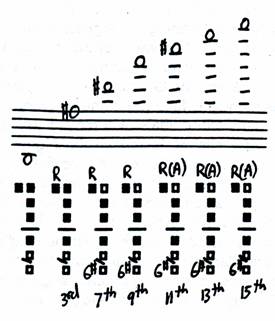| The Clarinet of the Twenty-First Century - E. Michael Richards |
CHAPTER 6 - Bass Clarinet
Alternate Fingerings
Different timbres of the same pitch on the bass clarinet are possible only through alternate fingerings; embouchure manipulation alone will not work, since it will also affect pitch. However, altering timbre is not the only purpose of alternate fingerings. The artistic bass clarinetist of the late twentieth century employs different fingerings from standard fingerings in certain musical contexts, throughout the traditional orchestral, chamber music, and solo repertoire.6 These contexts may require a slightly higher or lower pitch for reasons of intonation, a technically simpler fingering for a smoother legato, a less resistant fingering for an easier entrance at a soft dynamic level, or a more desirable tone color for better blend or portrayal of a particular musical character.
In music of the last twenty-five years, the expansion of timbral resources and sensitivities and of usable pitch nuances has become a primary compositional concern. However, in order to indicate (as a composer) and perform (as a bass clarinetist) alternate fingerings, one must understand the acoustics of the instrument. All pitches on the bass clarinet do not lend themselves to alternate fingering possibilities. In general, the pitches which utilize the longest length of tube have the fewest options; pitches below B3 and pitches between B4 and G5 have few or no alternate fingerings.
Example #6
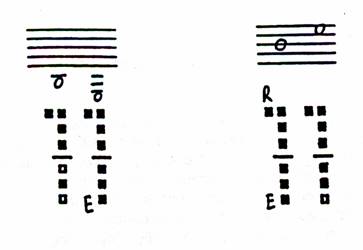
Pitches in the altissimo register have the most alternatives, since they can serve as partials to a number of different fundamentals.
The top half of the chalumeau register (B3 to A4) offers a variety of "covered" sounding (few strong partials) alternate fingerings. Some of these are cross-fingerings (fingerings that employ open vents, higher on the instrument body than the lowest tone holes that are closed by fingers or keys) which can only be produced at a very soft dynamic level with a minimum of upper partials present.
A chart of fingerings (B3 - G5) suitable for rapid alternation with the regular fingering of the same pitch, follows (Table #1). Those which can not be alternated at a rapid speed have been labeled nf (not fast). The intonation of these pitches is extremely close to the regular fingering; only minor adjustments of the type made in normal tuning while playing may be necessary. Those pitches which may exhibit noticeable tuning discrepancies have been labeled (sl = slightly low, etc.)7.
nf = not fast
sl = slightly low
sh = slightly high
st = stuffy (resistant)
Table #1 (click on measure for mp3)
[only D, F#, B, and A sound files linked here]
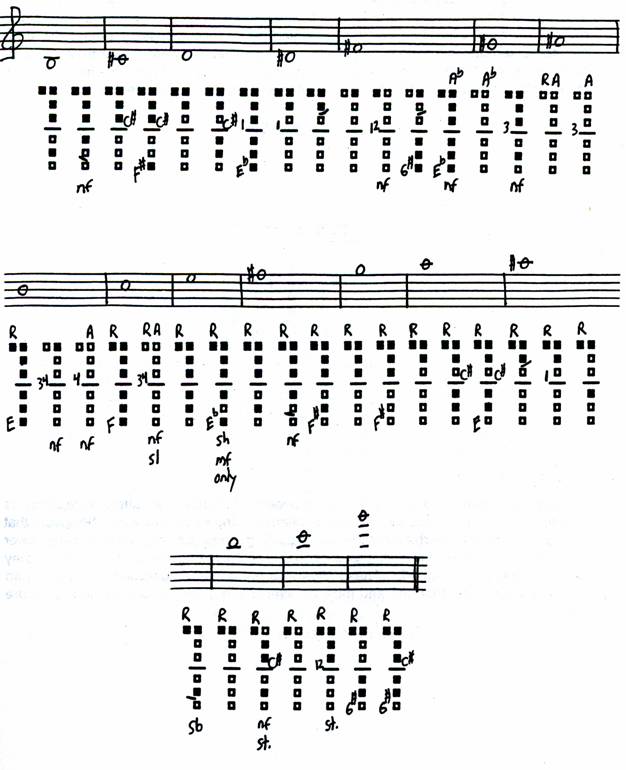
Spectrograms for the conventional fingering for D3 and two alternate fingerings show the greatest strength of partials 1,3,5,7 in the spectrum of the conventional fingering. The second alternate fingering is especially muted – it contains only strong 1st and 3rd partials, complemented with a more prominent 2nd partial than with the other fingerings. Partials above the 3rd are practically absent in the spectrum of this alternate fingering.
D3
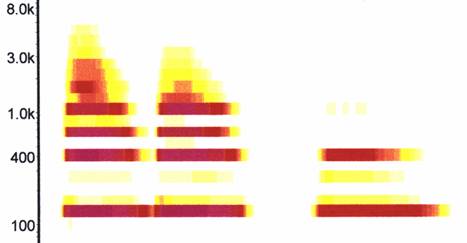
The spectrograms below for F#3 indicate that the first alternate fingering has the richest set of partials. The second alternate fingering has a weaker 3rd partial coupled with a fairly strong 5th partial. The third alternate fingering owes its extremely muted timbre to nearly 100% of its energy centered in the fundamental.
F#3
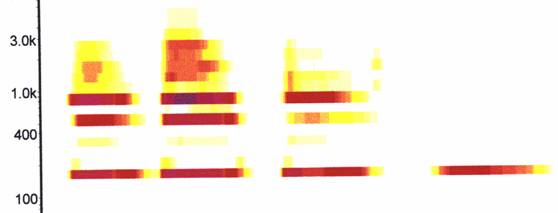
An abundance of alternate fingerings exist for pitches in the altissimo register. Paul Drushler has very clearly described the acoustical link between basic fingerings and registers of the clarinet (Example #9a). Third partials (clarion register) are produced by depressing the register key (thus opening the register hole). Fifth partials (C-sharp5 - A-sharp6) are produced by lifting the first finger of the left hand, in addition to the register key. This permits the LH1 tone-hole to act as a vent. Seventh partials, and higher, are generally produced by depressing the G-sharp key in addition to the others mentioned. At least the outline of this formula is followed in the following example (Example #9b). It is important to note that many fifth partials also require the G-sharp key, and that other vents (A key) are utilized for pitches based on the highest partials. In addition, the highest pitches are often derived from "out of tune" partials of unrelated fundamentals. It is clear that the desirable method for developing fingerings consists of starting with a fundamental, selecting vents, and making final alterations by opening and/or closing various tone holes. According to Drushler, "variations in pitch, timbre and stability for specific altissimo notes can be discovered by experimenting with modifications of basic fingerings."8 With the bass clarinet, the position and degree of pressure placed by the embouchure on the reed allows control of a greater range of altissimo notes than on the soprano clarinet (up to G-sharp6!). It is possible to play on the 13th and 15th harmonics of a given fundamental.
Example #9a (click on music for mp3)
#9b (click on music for mp3)
Note, below, how the presence and strength of upper partials fades as one moves up the fingerings of the harmonic series. The first fingering contains strong 1st , 3rd , 5th , and 7th + partials. The fingerings based on the 11th -15th partials all contain strong 2nd partials.
B--------------F#--------------------- D#---------------------- A---------------- C#
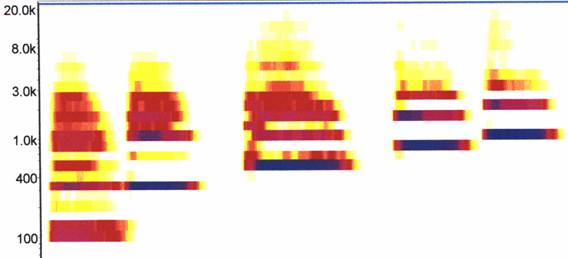
E--------------------- G
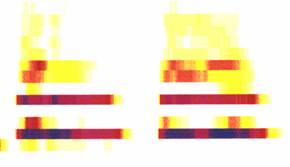
The following chart (Table #2) of alternate fingerings contains only a few of the many choices for altissimo register pitches. No unusual techniques are called for, however, such as half-depression of pad keys. Slight deviations in pitch may exist, but these are easily corrected by adjustments of embouchure and air pressure. These adjustments are no more extreme than those that one would make to play in tune with other performers; they merely require a sensitive "auditory image." Since different players play different equipment, the tuning will be slightly different for each individual. An aspect such as how far a particular pad comes away from a particular tone-hole can be very significant. In the same manner, pitches from the microtone charts may work as alternate fingerings; however, one runs the risk of timbre distortion as one becomes further and further from the pitch of the original fingering.
The annotations under each fingering are arranged according to the following format:
line # information
I - partial of fundamental that fingering is based on/fundamental pitch (i.e. 5th/C4); (C4m = modification of C4 fundamental fingering)
II - timbre: br = bright; br! = very bright; d = dark; s = slightly; st = stuffy
III - dynamics - ppp to fff
IV - intonation - l = low; h = high; s = slightly
V - articulation - res = resistant, difficult to begin immediately; s = slightly
VI - preparation - com = a complex fingering; player must have time to prepare it; legato connection to it may not be possible; sm = smooth connection from another pitch possible; sm! = very smooth connection from another pitch possible
Blank fingering grids have been included so that the reader might add his/her own fingerings.
Table #2 (click on pitch for mp3)
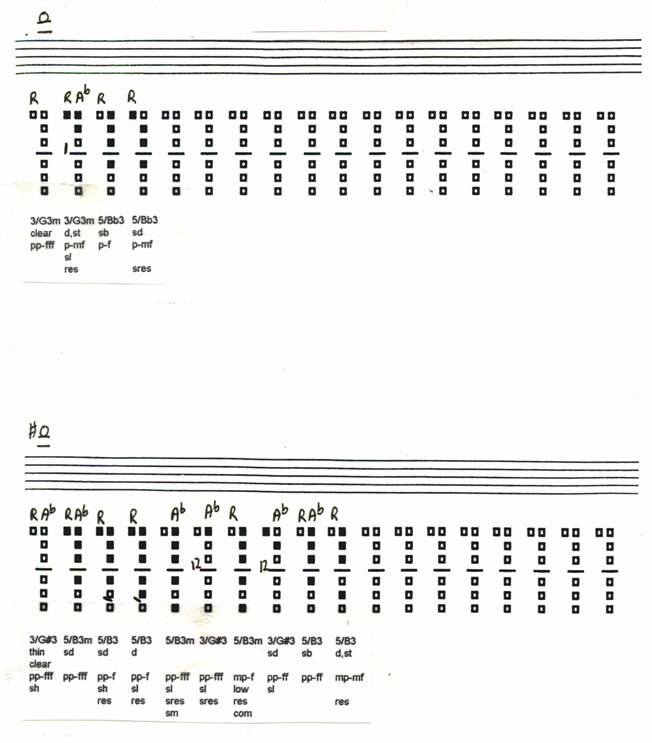
for information on how to see/hear more examples of alternate fingerings, including all sound files, click here
|
||

